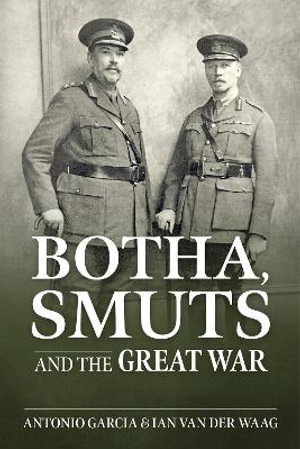
PublishedHelion & Company, February 2023 |
ISBN9781915113771 |
FormatSoftcover, 184 pages |
Dimensions22.9cm × 15.2cm |
The authors conducted painstaking research in South Africa and the United Kingdom to produce this, first-of-a-kind book on the wartime roles played by the South African prime minister, General Louis Botha, and his deputy, General Jan Smuts. These were very different men and they appealed to different audiences.
Botha's nuance and emotional intelligence complemented Smuts's intellectualism. Thrown into a world conflagration in August 1914, Botha and Smuts - facing internal rebellion and the threat posed by German troops on their borders - led South Africa's Union Defence Force, and often commanded from the front. South Africa's campaigns began badly. The campaigns in German South West and East Africa started with reverses at Sandfontein in September 1914 and Salaitia in January 1916. However, Springbok soldiers of all backgrounds proved resilient, and the later campaigns were marked by near uniform success. The "first-battle" experiences had reshaped thinking and led to better leadership and command at all levels. Both Botha and Smuts commanded in the field. Steadily, the South African army they commanded - benefiting from wartime training, sometimes in the field - gained resilience, experience, and battle-hardiness, adapting to the conditions of the campaigns and the demands of the tasks. South Africa's campaigns were complex and divergent, starting with the invasion of neighbouring German South West Africa - to neutralise the radio stations and so aid security in the South Atlantic. Suddenly suspended following the outbreak of the Afrikaner Rebellion, the campaign recommenced in January 1915. Following its conclusion, an infantry brigade, raised for the Western Front, was diverted to Egypt before facing near annihilation at Delville Wood. Reconstructed more than once, the brigade was accompanied by a field ambulance and general hospital. The South African deployment in France included two brigades of heavy artillery, a signal company, a railway company, and Auxiliary Horse Transport Company, and several South African Native Labour Contingents. At the same time, a large South African force, fighting alongside troops from British Africa and India, broke German resistance in East Africa, and a brigade of field artillery and later the Cape Corps served in Egypt and Palestine. In addition, more than 6 500 South Africans served in the British Army, the Royal Flying Corps, later the Royal Air Force, and on ships of the Royal Navy. Although lionised during the war by a British public hungry for heroes, there is a different side to Botha and Smuts. Shunned by Afrikaner nationalists at the time, they have remained divisive figures. Responsible for the enactment of the Land Act of 1913, which shaped South Africa's socio-economic and political landscape, Botha's statue in Cape Town was vandalised in 2015 and 2016. Behind his charming, attractive facade, and Smuts's stoic machine, were two very human, imperfect, and quite probably inconsiderate, men. Together they provide a wonderful lens through which to examine the potent forces of the early twentieth-century world and the country they hoped to forge. Myopic compatriots had constrained their plans; but it was the outbreak of war in 1914 that offered the most significant opportunities and brought the most adverse challenges. They fought insurmountable odds, and achieved great victories, at home and abroad, but also made startling errors, and, ultimately, in classical fashion risked being crushed by the weight of the world they tried to create. AUTHORS: Tony Garcia is Research Fellow at Stellenbosch University. His latest book publication The First Campaign Victory of the Great War was published by Helion in 2019. Ian van der Waag is Professor and head of Department of Military History at Stellenbosch University and a fellow of the United States Military Academy West Point Summer Program. He completed an MA at the University of Pretoria, and a PhD at the University of Cape Town and has published widely on South African military history. 15 ills & 3 maps

